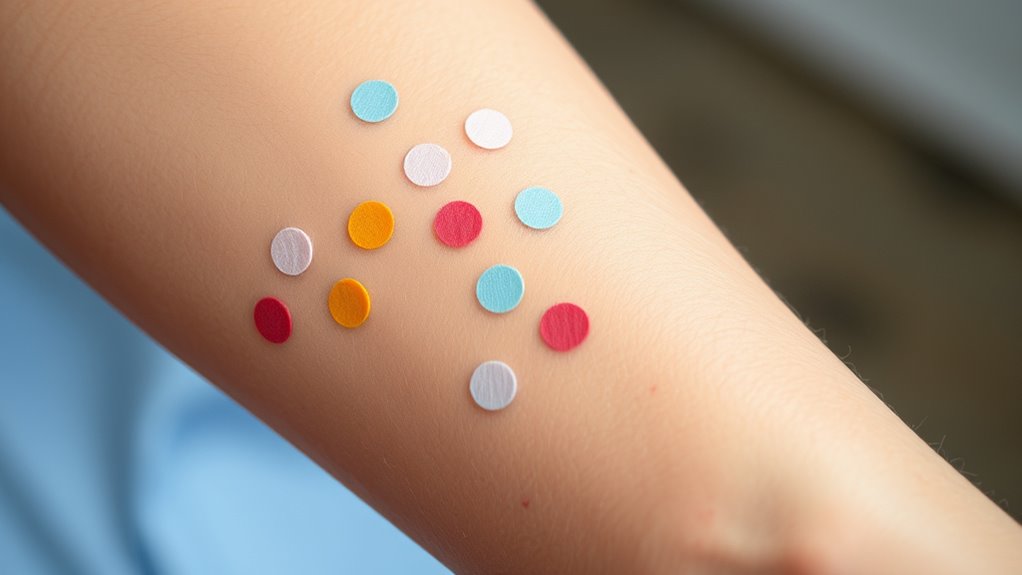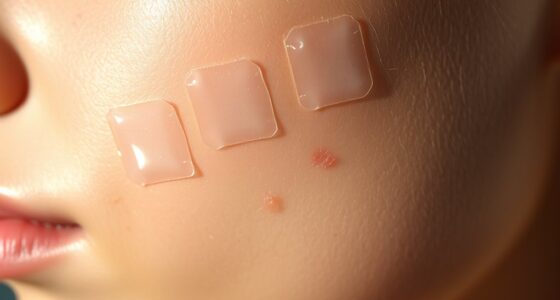If you’re concerned about allergic reactions during patch testing, watch for symptoms like redness, swelling, itching, or blistering at the test site, especially after removing the patches. Serious signs like difficulty breathing or dizziness require immediate medical attention. The test helps identify triggers, so knowing what to look for guarantees you stay safe. Keep track of your symptoms and follow your provider’s instructions closely to prevent complications; you’ll discover more ways to ensure safe sensitivity management.
Key Takeaways
- Watch for skin redness, swelling, itching, or blistering at patch test sites during and after removal.
- Be alert to signs of allergic reactions like difficulty breathing, hives, or throat swelling.
- Avoid getting the patches wet or sweating excessively during the 48-hour testing period.
- Report any unusual or severe reactions to your healthcare provider immediately.
- Follow post-test instructions carefully to ensure accurate results and prevent adverse effects.

Allergic reactions can cause uncomfortable symptoms and make daily life challenging. Whether it’s through skin contact or inhalation, knowing what triggers your allergies is essential to managing them effectively. One common source of allergic reactions is latex allergies, which can cause symptoms ranging from skin irritation to more serious reactions like difficulty breathing. People with latex allergies often find that contact with latex gloves, balloons, or certain medical equipment leads to redness, swelling, or itching. It’s important to recognize these signs early to prevent more severe reactions. Additionally, skin irritants—substances that cause irritation but not an allergic response—can also cause discomfort. These irritants might include soaps, detergents, or certain chemicals found in skincare or cleaning products. While irritants don’t involve an immune response like true allergies do, they still lead to redness, dryness, or burning sensations on your skin.
When you suspect allergies or skin irritants are affecting you, patch testing is a common method used by dermatologists to identify specific triggers. During a patch test, small amounts of potential allergens are applied to your skin, usually on your back, under patches that stay in place for 48 hours. You’ll need to keep the patches dry and avoid sweating or bathing during this period. Once the patches are removed, your doctor will examine your skin for signs of a reaction—such as redness, swelling, or blisters—that indicate an allergy or irritation. The goal here is to pinpoint exactly which substances cause your skin to react, so you can avoid them in the future. If you have latex allergies, patch testing can confirm your sensitivity to latex and help you take precautions, like choosing non-latex gloves and avoiding products containing latex.
It’s essential to understand that not all skin irritations are allergies. Some reactions might be due to irritants that damage your skin’s outer layer without involving your immune system. However, a positive patch test for latex allergies or other substances can markedly improve your quality of life by guiding you to avoid specific triggers. Once you know what’s causing your symptoms, you can better manage your environment—using hypoallergenic products, wearing protective gear, or opting for alternative materials. Proper equipment protection and careful material selection are crucial steps in preventing allergic reactions. Remember, prompt identification of skin irritants and latex allergies can prevent escalation into more serious health issues. If you experience persistent or worsening symptoms, consult a healthcare professional who can perform patch testing and help you develop a tailored plan to minimize your exposure and keep your skin healthy.
Frequently Asked Questions
Can Patch Testing Cause False Positives or Negatives?
Yes, patch testing can cause false positives or negatives. You might get a false positive if your skin reacts to a substance that isn’t causing your allergy, leading to unnecessary worry. Conversely, false negatives happen when your skin doesn’t react even though you’re allergic, possibly missing an allergy. Factors like skin condition, testing method, or medication can influence these results, so discuss any concerns with your healthcare provider.
How Long Do Patch Test Results Take to Interpret?
You can expect the timing expectations for patch test results to take about 48 to 96 hours, sometimes up to a week. During this period, your healthcare provider will carefully review the test sites and interpret the results. It’s important to follow their instructions closely and attend follow-up appointments, as result interpretation requires examining skin reactions over time to accurately identify allergies.
Are There Any Risks for Children During Patch Testing?
You should know that patch testing is generally safe for children, but there are some risks involved. While allergic reactions are rare, children’s safety remains a priority, so medical professionals monitor them closely during the test. The goal is effective allergy management, guaranteeing your child’s comfort and safety. Always discuss any concerns with your child’s doctor beforehand to minimize risks and ensure the procedure is appropriate for their age.
Do Medications Affect Patch Test Accuracy?
A stitch in time saves nine, they say. Medications can affect patch test accuracy because certain drugs, like antihistamines or corticosteroids, may suppress skin reactions. To guarantee reliable results, you should usually stop these medications before testing, as medication interactions can mask allergic responses. Always follow your healthcare provider’s instructions to avoid skewed test outcomes and get the most accurate diagnosis possible.
How Should I Prepare My Skin Before Patch Testing?
Before patch testing, you should cleanse your skin thoroughly with gentle soap and water to remove oils and dirt, guaranteeing accurate results. Avoid applying creams, lotions, or makeup on the test area, and stay away from allergy triggers like certain soaps or skincare products. It’s best to avoid allergy avoidance measures that could interfere with the test, and follow your healthcare provider’s instructions for skin preparation to ensure reliable results.
Conclusion
Stay vigilant for allergic reactions; they can appear as a sudden flare of redness or a stubborn itch that spreads like wildfire across your skin. Patch testing helps identify these hidden culprits, guiding you to clearer, calmer days ahead. Imagine your skin as a peaceful lake, rippling with irritation—once you pinpoint the cause, you can gently restore its tranquil surface. Keep an eye out, and take control of your skin’s story.
Claire has a knack for turning complex dermatological concepts into engaging, easy-to-understand articles. Her work primarily focuses on creating detailed reviews and thought-provoking articles in the “Vetted” category. Claire’s writing not only informs but also inspires our community to try new skincare solutions.










